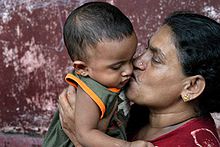Gender roles in Sri Lanka
This article needs additional citations for verification. (March 2016) |
 Sri Lankan woman and child | |
| Global Gender Gap Index[1] | |
|---|---|
| Value | 0.676 (2018) |
| Rank | 100th |
| Part of a series on |
| Women in society |
|---|
 |
All ethnic groups in Sri Lanka have many distinctions regarding the roles of the sexes. Sri Lanka was the first nation in the world to elect a female head of state, Sirimavo Bandaranaike. Bandaranaike won the election in 1960 after S.W.R.D. Bandaranaike, the preceding leader who was also her husband, was murdered by a spy.
While Sri Lanka relatively excels when it comes to gender equality indices, there are still many underlying issues pertaining to gender inequality in Sri Lanka.[2]
Many Women in Sri Lanka choose to work, while some choose to work at home and care for children. In families relying on agriculture, women are in charge of weeding and help with the harvest. Among poor families, women also perform full-time work for upper class individuals. Moreover, the man's role used to be seen as providing his family with material support by looking after his business.
At the center of the hierarchy are children, who mix freely and receive a great deal of affection from both sexes. Among the middle- and upper-income classes, education of children may last into their early twenties, and women may mix with males or even take on jobs that were in the past reserved for men. For poorer income children, they may go to work at an earlier age.
Gender inequality
In comparison to other countries in the region, Sri Lanka is ranked well on several gender equality indices. However, there are also some sources that question the validity of these indices.[3] Furthermore, globally, Sri Lanka ranks relatively low on gender equality indices.[4] Overall, this pattern of social history that disempowers females produces a cycle of undervaluing females, providing only secondary access to health care and schooling and thus less opportunities to take on high-level jobs or training. In a study by Dr. Elaine Enarson, this cycle in turn worsens the issue of low political participation and social rights.[5]
Further reading
- Perera-Desilva, Vidarshani Nadeesha (January 2015). "Psychological counselling for women garment factory workers of Sri Lanka". Asian Journal of Women's Studies. 21 (1): 65–76. doi:10.1080/12259276.2015.1029231.
{{cite journal}}: Invalid|ref=harv(help)
References
- ^ "The Global Gender Gap Report 2018" (PDF). World Economic Forum. pp. 10–11.
- ^ "Gender Inequality Index (GII) | Human Development Reports". hdr.undp.org. Retrieved 2015-10-22.
- ^ Dijkstra, A. Geske (1 July 2006). "Towards a Fresh Start in Measuring Gender Equality: A Contribution to the Debate". Journal of Human Development. 7 (2): 275–283. doi:10.1080/14649880600768660. ISSN 1464-9888.
- ^ "United Nations Statistics Division - Demographic and Social Statistics". unstats.un.org. Retrieved 9 October 2015.
- ^ ILO, Elaine Enarson, Crisis Response and Reconstruction (1 September 2000). "Gender and natural disasters". www.ilo.org. Retrieved 2 November 2015.
{{cite web}}: CS1 maint: multiple names: authors list (link)
| This image is available from the United States Library of Congress Prints and Photographs Division under the digital ID {{{id}}} This tag does not indicate the copyright status of the attached work. A normal copyright tag is still required. See Wikipedia:Copyrights for more information. |
(Data as of 1988.)
